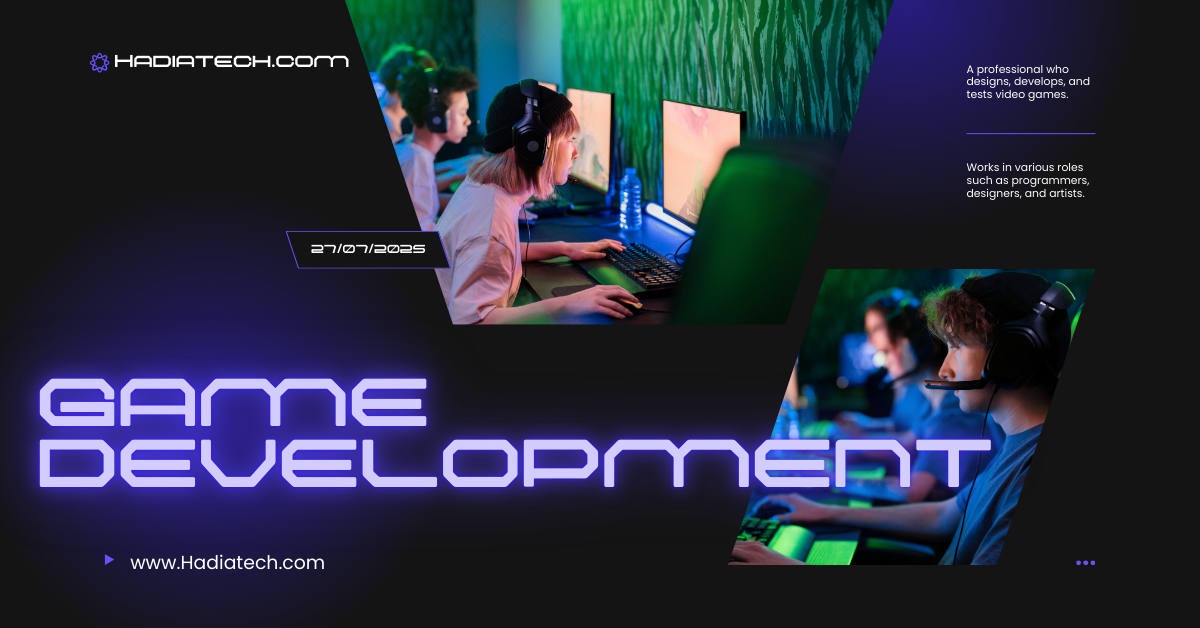Game Development in 2025: Trends, Tools & What’s Shaping the Future
If you’ve been paying even a casual attention to the game development universe, you’ll be aware that we’re no longer in the same league as we were five, even two years ago. 2025 game development is a radical departure from the past — and for the better. With the growth of AI, immersive tech, and cross-platform support, we’re in the midst of a revolution that’s transforming how games are created and played.
Whether you’re an aspiring game developer, a hobbyist, or just someone fascinated by the behind-the-scenes magic, this post breaks down what’s happening in game development this year — the trends, the tools, and what it means for the future of interactive entertainment.
1. Unreal Engine 5 and the Era of Photorealism
Let’s begin with what’s perhaps the most potent weapon at the developer’s disposal today: Unreal Engine 5. The engine developed by Epic Games has officially entered mainstream territory in 2025, driving AAA games to indie experiments.
The crown jewels? Nanite and Lumen. Nanite lets creators bring in movie-quality assets seamlessly without murdering the performance, while Lumen creates real-time global illumination. To put it simple, it is movie-quality visual in real-time gameplay — and it’s amazing.
We’re seeing game developers push boundaries with environments that feel real, right down to the way light bounces off wet pavement or filters through a dusty window. The line between cinematic and playable has blurred beyond recognition.

2. AI in Game Development: Not Just Hype Anymore
We’ve heard about AI for years, but in 2025, it’s no longer a buzzword — it’s an everyday tool in the dev workflow.
Developers now leverage AI to:
- Create environments and textures with such tools as NVIDIA’s GauGAN and AI plugins in Unity and Unreal.
- Make dynamic NPC behaviors so games are less scripted and more responsive.
- Test gameplay loops and find bugs before even human testers lay a finger on the controller.
- Of course, AI isn’t substituting for human creativity — not by a long shot. But it’s automating the mundane stuff, allowing teams to concentrate on design, narrative, and sheen.
3. Cross-Platform is the Norm, Not the Feature
Those days are behind us when a game releasing on PC, console, and mobile was a major event. In 2025, cross-platform development is business as usual, thanks to improved engines and more convergent development pipelines.
Environments such as Unity, Godot 4.2, and even Epic’s recent advancements with Verse (their new scripting platform for metaverse and gaming applications) are facilitating it more than ever before to deploy your game on multiple platforms without needing to begin anew for each.
And with cloud gaming platforms such as Xbox Cloud, NVIDIA GeForce Now, and even Netflix’s surprisingly robust game streaming service, your game might be playable on anything from a console to a smart fridge.
4. The Return of Indie Games and Solo Developers
Here’s something that may surprise those outside the dev community: the biggest creative gambles in 2025 aren’t being made by large studios — they’re being made by bedrooms and basements.
Thanks to powerful tools, asset marketplaces (such as itch.io, OpenGameArt, and Unreal Marketplace), and crowdfunding platforms, one-man and small indie teams are flourishing. Some of the most viral games of the year are created by one or two individuals with a singular vision and the talent to make it happen.
Games such as Dave the Diver and Hollow Knight: Silksong influenced a generation, and for 2025, we’re now seeing the payoff — offbeat, emotional, gorgeous-looking games with specialist appeal and huge heart.
5. VR and AR: Not the Future — the Present
At one point, it seemed like VR was always about to break into the mainstream. In 2025, it finally does.
Meta Quest 3, Apple Vision Pro, and HTC’s mini standalone headsets have democratized immersive gaming and de-gimmified it. Simultaneously, AR gaming has gone under the radar, with the likes of Peridot and Minecraft Earth 2.0 showing there is genuine demand for augmented experiences that merge the digital and physical worlds.
Most thrilling is how developers are bringing VR/AR capabilities without committing fully, providing optional modes or hybrid interfaces that enable their games to be played with or without a headset.
6. Storytelling is Evolving — and It’s More Player-Driven Than Ever
Narrative design is receiving a serious overhaul in 2025. With branching stories, persistent decisions, and procedural dialogue systems, players have more agency over how the story progresses.
Games like Pentiment, Disco Elysium, and Baldur’s Gate 3 set the standard for deep, reactive storytelling — and now we’re seeing even more developers pick up the torch.
Interactive fiction tools like Ink and Twine have also seen a resurgence, especially in the indie scene, making it easier to prototype and launch narrative-heavy experiences.
7. Monetization is Shifting: Players Want Value, Not Gimmicks
Loot boxes and aggressive microtransactions? That ship has (mostly) sailed. In 2025, players are rewarding studios that respect their time and money.
We’re seeing more games development adopt models like:
- Battle passes that offer real value and cosmetic progression.
- One-time purchases with meaningful content.
- Subscription access via Game Pass-style services, helping smaller studios reach wider audiences without risky upfront sales.
- Even mobile games are pulling back on aggressive monetization in favor of longer retention and better community engagement.
8. Education and Learning Are More Accessible Than Ever
Thinking about learning game development yourself? You’re in luck — resources in 2025 are next-level.
From online platforms like Udemy, GameDev.tv, and Coursera to real-time AI coding assistants built into engines, it’s easier than ever to go from beginner to launch-ready. Plus, with communities on Discord, Reddit, and GitHub more active than ever, you’ll never be learning alone.
Some universities are even offering fully remote, project-based degrees in game design, focused more on portfolios than exams — a refreshing change for creative fields.
Final Thoughts: Game Development in 2025 is a Playground of Possibility
It’s an exciting time to be involved in game development. The tools are more powerful, the communities more supportive, and the creative ceiling has never been higher. Whether you’re a programmer, artist, storyteller, or just someone curious about how games are made, 2025 offers more opportunities to build something meaningful than any year before.
The line between player and creator is blurring. With platforms like Roblox, Fortnite Creative 2.0, and Core, players are turning into developers — and vice versa.
So, whether you’re dreaming of your first indie title or just keeping an eye on the trends, remember: game development in 2025 isn’t just about code and engines — it’s about passion, creativity, and the joy of bringing ideas to life.




